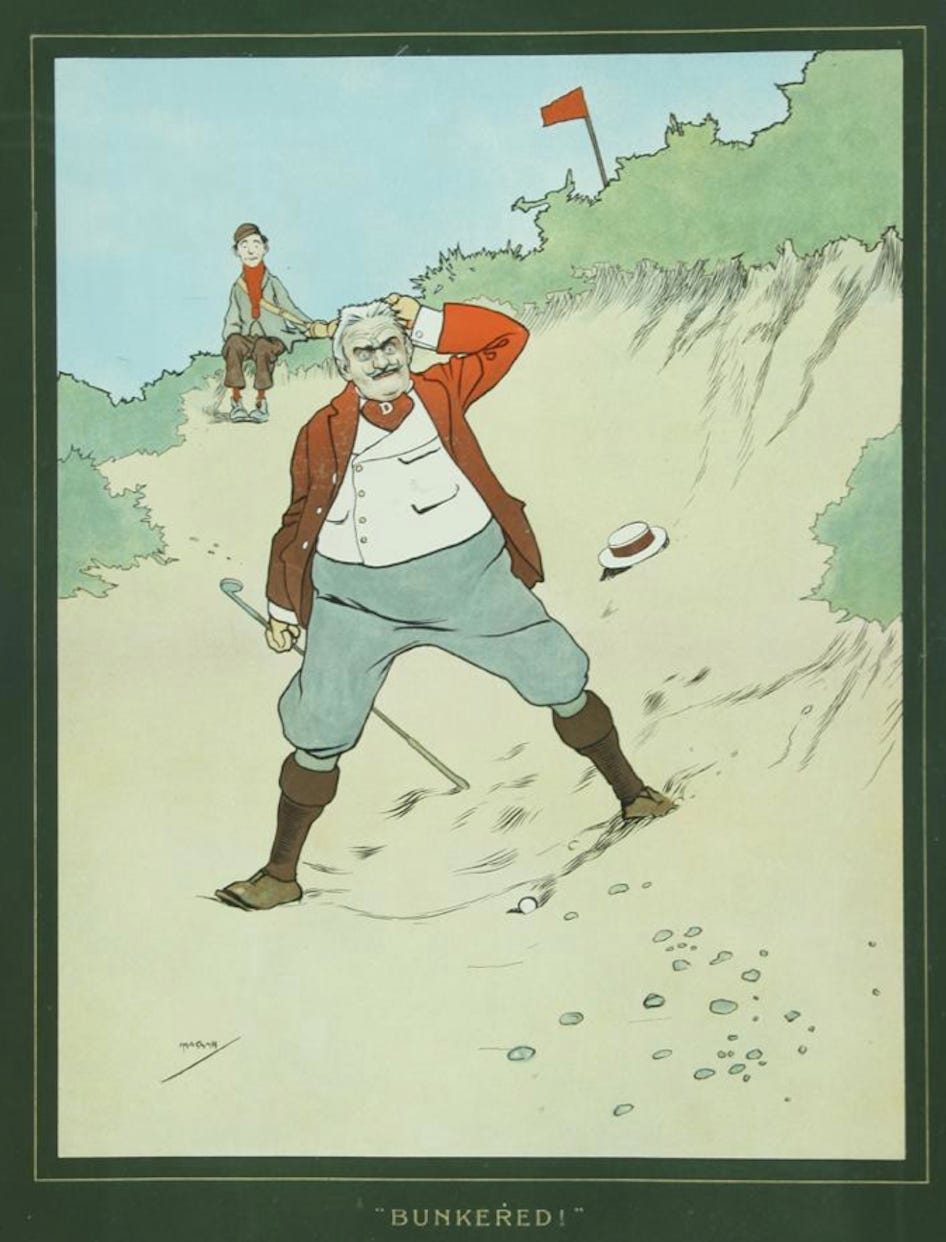'A hackers guide to breaking 90’
Golfers should take a deep breath and realise that playing to a 20 handicap is the norm and all these A graders and B graders are playing a completely different game to the majority. Lets call them golfers and the majority floggers. (Flog is Golf in reverse). Most floggers, in Australia, have a handicap of 20 and above (male), and 30 and above (female) yet are consistently exposed to ‘swing tips’ and posture alignments designed for professionals and golfers who hit greens in regulation. This story is aimed fairly at the middle of the green, with a pitching wedge in hand and we are sure to end up chipping for par, not putting for birdie. This is ‘the floggers way.’ So lets accept our game, or lack thereof, and consider some basics we can do to try and break that magic number of 80 … I’m kidding, lets keep it realistic and look at all the stars that need to align to break 90…
While most golfers arrive an hour before their tee time, having done a series of stretches and warm up routines; potentially undertaken some form of meditation and mental strength building exercises after eating a low carb meal specifically designed to improve their metabolism through holes 12-15, some floggers are more likely to have got to bed at 2am the night before and arrived at the first tee holding a microwaved slice of pizza in one hand and wondering if they should get a 6 pack of beer before they tee off. Others might have only managed to get the ‘leave pass’ to play golf 10 minutes before their tee time and arrive in a cloud of chaos into the carpark with not a moment to even have a practice putt. This is a standard behaviour. Standing on the first tee and not having held a golf club for several weeks, you are as prepared as you have ever been. Forget what they are telling you on the tv.
Generally speaking we need to accept that a good nights sleep and a healthy breakfast are two simple steps towards the magic number of 89. Arriving at the first tee having had time to chip a few balls and loosen up the aging tendons and ligaments should also be added to the notes, but for heavens sake don’t take it too seriously. Floggers should have an air of calm that golfers cannot possible attain. There should be no stress and this is note number 4.
One of the gurus of the ‘chipping for par’ methodology is the elusive David Osborn, who is regularly consulted by floggers for his yoda-like understanding.
“I think the key when chipping for par is not to panic and keep in mind that the double bogey will get you at least one point. Poor floggers tend to panic and end up with a wipe.” (stableford)
This is sage advice from the once 18 marker, and put into floggers terms, what Mr Osborn is saying is you are not trying to get it up and down (from the side of the green) like they do on television. If you are chipping, you are trying to get the ball onto the green… and then 2 putt. Sounds easy right? If you try for anything more than this, you put pressure on yourself and that might cause panic and the unthinkable. So, set your expectations very low and if you happen to get lucky, it is a bonus. This takes all the pressure off your ailing mind and shoulders. It is genius. The professionals and golfers could take notes on the floggers mindset, Zen like. Pressure, pffft. What pressure.
Talking to PGA professional Tom Berndt from the Hills International academy of golf, we asked Tom for some prudent advice for mere mortals and he said what we were all fearing. ‘Improve their distance control from 8 to 20 mts with their putts - If they can nestle the ball close they would save a number of unnecessary 3 putts.’ If you are putting from 15 meters, the crucial thing to think about is the length. Sadly for many of us we watch the professionals on television and they think about the line AND length on a 15 meter putt, actually thinking about two things at once. This is something the golfers and professional can do, but for floggers try it at your own peril. On a 15-meter putt, only think about speed, you will instinctively aim the ball towards the hole. See the ball rolling out to the desired length. Get the speed right.
Television and professional golfers are sending us floggers the entirely wrong message. We really should not try to copy them. They are nothing like us. They don’t have problems like we do. Not real ones anyway, like trying to re-focus the mind after hitting a shank in front of the clubhouse or having to ask a playing partner politely if they can lend you a golf ball as you just lost your last one in someone’s backyard and still have 8 holes to play. These are real problems.
Watching a professional or a golfer chip with a lob wedge from the side of the green makes floggers think they should too, but this shot if fraught with danger. It should only be undertaken after extensive training and lets face it, floggers don’t train. Even PGA professional Tom Berndt agreed. ‘Forget about that’ he said. Rather he advised ‘have a sound chip and run shot that can get the ball relatively close without playing a spectacular lob shot.’ Try different clubs for the chip and run, most floggers tend to use a 7 iron, but remember it is just a number. Some use a rescue club and some floggers get fancy and use many different clubs for chipping. There is no need to be fancy, just try and get proficient with one club and learn to feel how far it will roll along the ground, again a chip is all about the length of shot, you will instinctively aim towards the hole…flogger like. Your mission? To chip the ball onto the green and two putt.
Tom Berndt also offered to ‘Picture the shot that they CAN play in their mind and stay connected with that picture/feel.’ Now this is worth some thought….and it should be taken with a teaspoon of reality. Picture your shot. That is right, picture the raving slice flying through the air, you can feel it is going to happen so don’t fight it, go with that picture. If your picture is a hook, then see the picture and stay connected…but under no circumstances try and convince yourself the ball will go straight. The only time to do that is over a five-footer.
Bunkers…the floggers dread. To hit a good bunker shot you need to hit the ground approx 6 inches behind the ball and accelerate through the shot. Most floggers hit the ground about a yard behind the ball and decelerate, or they thin the golf ball over the lip of the bunker and into the adjacent carpark. Remedy….go to a practice bunker, draw a line in the sand and try and take a full swing and get the clubhead to hit that line in the sand. You will hit behind the line and in front of the line. That is your problem and it can be fixed.
Floggers all have their own unique way of putting, unlike golfers. Golfers all look the same, robot-like. Embrace your unique style and putt with vigour, enthusiasm and, most importantly, joy. Expect to miss putts from 18 inches, it is part of your job description and proper floggers don’t get angry…no… they laugh at their adversity and know that pretty soon a long winding putt will roll in and secure them a 3 pointer.
Swing speed with a driver or 3-wood is something that comes naturally to all floggers. You do not need to try and get extra club head speed, leave that for golfers. Moreso what floggers need to do is find their own biorhythm, which is a fancy word for their own unique tempo. You have one and it is yours. If you try and make it go faster, you will probably fall over. Once you are at peace with your own tempo, find a long club to hold that looks good and makes you feel happy and let that club swing, the ball will zoom off the club face and perhaps trundle off left, or right, but it will go perfectly far enough without too much effort on your behalf.
The secret to you breaking 90 is not with the driver, it is around the green and chipping for par. Moreso it is a mental toughness, an attitude of indifference that hinges around extremely low expectations and a keen sense of pessimism.
It is also important to choose your playing partners wisely, especially if you are reaching for the dizzy heights of breaking 90. You want partners who will see your lofty goals and not try to drag you down and belittle your dreams. Sometimes it might help to be paired with proper golfers, but be advised this can lead you astray and make you attempt golf shots that require training, practice and skill; three things you are unfamiliar with.
Generally speaking floggers should stick together, learning from each other and if you so happen to advance out of the flogger family and into the niche world of a proper golfer, well kiss your flogger friends goodbye and all of the flogger traits. If you become a proper golfer you will miss out on all sorts of lifestyle choices that the flogger takes for granted; lack of sleep, poor diet, alcoholic beverages at the halfway house, multiple alcoholic beverages if you failed to break 60 on the front nine, post round banter and discussions about your fifth shot out of the bunker or how you possibly racked up a 13 after a perfect drive. There is a price to pay if you leave the flogger ranks, your golf life gets serious and your fellow members expect you to perform. It’s stressful and not advisable.
Note: If you apply this methodology to your own game, you can expect to shoot 93, 90, 91 and 92 several times before you write down 86 and walk into the clubhouse with your head held high only to realise you lost to someone off 33 who shot 99.
By Andrew Crockett
*art by the late John Hassall (1868–1948).




